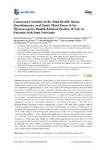| dc.contributor.author | Palomo-López, Patricia | |
| dc.contributor.author | López-López, Daniel | |
| dc.contributor.author | Becerro-de-Bengoa-Vallejo, Ricardo | |
| dc.contributor.author | Losa Iglesias, Marta Elena | |
| dc.contributor.author | Rodríguez Sanz, David | |
| dc.contributor.author | Fernández-Carnero, Josué | |
| dc.contributor.author | Martiniano, João | |
| dc.contributor.author | Calvo-Lobo, César | |
| dc.date.accessioned | 2019-12-03T16:22:50Z | |
| dc.date.available | 2019-12-03T16:22:50Z | |
| dc.date.issued | 2019-11 | |
| dc.identifier.citation | Palomo-López, P.; López-López, D.; Becerro-de-Bengoa-Vallejo, R.; Losa-Iglesias, M.E.; Rodríguez-Sanz, D.; Fernández-Carnero, J.; Martiniano, J.; Calvo-Lobo, C. Concurrent Validity of the Foot Health Status Questionnaire and Study Short Form 36 for Measuring the Health-Related Quality of Life in Patients with Foot Problems. Medicina 2019, 55, 750. | es_ES |
| dc.identifier.issn | 1010-660X | |
| dc.identifier.uri | http://hdl.handle.net/2183/24424 | |
| dc.description.abstract | [Abstract] Background and Objectives: Foot problems may be considered to be a prevalent condition and impact the health-related quality of life (QoL). Considering these Spanish-validated tools, the Foot Health Status questionnaire (FHSQ) may provide a health-related QoL measurement for specific foot conditions and general status. To date, the domains of the FHSQ and Medical Outcomes Study Short Form 36 (SF-36) have not been correlated. Therefore, the main aim of this study was to correlate the domains of the FHSQ and SF-36 in patients with foot problems. Materials and Methods: A cross-sectional descriptive study was carried out. A sample of 101 patients with foot problems was recruited. A single researcher collected descriptive data, and outcome measurements (FHSQ and SF-36) were self-reported. Results: Spearman’s correlation coefficients (rs) were calculated and categorized as weak (rs = 0.00–0.40), moderate (rs = 0.41–0.69), or strong (rs = 0.70–1.00). In all analyses, statistical significance was considered with a p-value < 0.01 with a 99% confidence interval. Statistically significant differences (p < 0.01) were found between all domains of FHSQ and SF-36, except for the mental health domain of the SF-36 with foot pain, foot function, and general foot health of the FHSQ, as well as between the vitality domain of the SF-36 and the general foot health domain of the FHSQ (p > 0.01). Statistically significant correlations varied from week to strong (rs = 0.25–0.97). The strongest correlations (p < 0.001) were found for physical activity and physical function (rs = 0.94), vigor and vitality (rs = 0.89), social capacity and social function (rs = 0.97), and general health domains of the SF-36 and FHSQ. Conclusions: The FHSQ and SF-36 showed an adequate concurrent validity, especially for the physical activity or function, vigor or vitality, social capacity or function, and general health domains. Nevertheless, the mental health domain of the SF-36 should be considered with caution. | es_ES |
| dc.language.iso | eng | es_ES |
| dc.publisher | MDPI AG | es_ES |
| dc.relation.uri | https://doi.org/10.3390/medicina55110750 | es_ES |
| dc.rights | Atribución 3.0 España | es_ES |
| dc.rights.uri | http://creativecommons.org/licenses/by/3.0/es/ | * |
| dc.subject | Foot | es_ES |
| dc.subject | Foot deformities | es_ES |
| dc.subject | Foot diseases | es_ES |
| dc.subject | Musculoskeletal diseases | es_ES |
| dc.subject | Quality of life | es_ES |
| dc.title | Concurrent Validity of the Foot Health Status Questionnaire and Study Short Form 36 for Measuring the Health-Related Quality of Life in Patients with Foot Problems | es_ES |
| dc.type | info:eu-repo/semantics/article | es_ES |
| dc.rights.access | info:eu-repo/semantics/openAccess | es_ES |
| UDC.journalTitle | Medicina | es_ES |
| UDC.volume | 55 | es_ES |
| UDC.issue | 11 | es_ES |






